|
|
Post by fiona on Sept 12, 2010 17:37:25 GMT -5
Shall we have a look at the faces? (I have been saving the best for last) snicker. First I will collage them.
|
|
|
|
Post by fiona on Sept 12, 2010 17:54:42 GMT -5
These two images are part of a set from the north facade of the building. They face each other. They are very much Victorian. The man wears a crown which stands for "victory over death." The woman wears a headband of stars, with a trailing ribbon, in the fashion of the day. She also wears a beaded necklace. All of these images are somehow related to those persons who either lived in the building, or were killed in the fire at the Genesee Flats. I do not know who these people are. Also, most images like this are terra-cotta. These are not. they are carved from the sandstone. 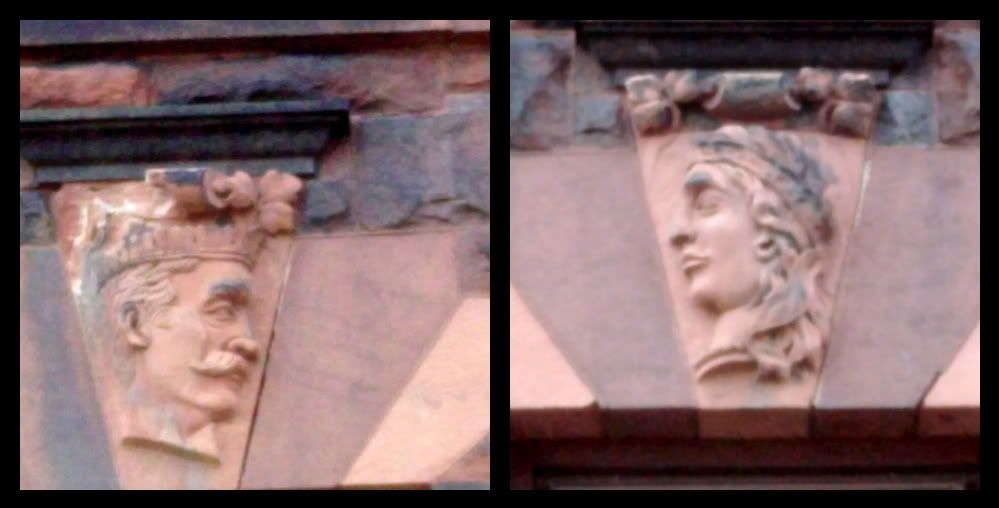 |
|
|
|
Post by fiona on Sept 13, 2010 17:40:57 GMT -5
You know Dave you have an excellent point there, about the Promethius myth and about the fact that there may be a story in all of these carvings and faces, if one knows how to read it. I have always thought that there was a story there and I think I have deciphered some of it, in the placement of the heads, To make a point, anyone who knew how to decode the riddle is long dead and perhaps, with the passage of time, it no longer mattered. People moved on. What I really need is for another person to study these carvings and see what comes to mind. Re the Corn, oil and wine: I had looked at this image a million times and could not decipher it. So I brought in a freind and he looked at it and knew at once what it was: an ear of corn. As you may know, corn was the basis, the basic grain used and celebrated in the Feminine Greek Mysteries of Eleusis, or the Eleusinion Mystery Schools. These acolytes were sworn to absolute secrecy on pain of death. Very liitle of what transpired during the rites has been passed down. Also, the bull was celebrated to as a symbol of fertility through out the ancient world and that thread still survives today in Bullfighting, running of the bulls, ect. We are on to something here. Another point is that Latcher died of Jacob's Angina, which is a peridontal disease common in the 19th century, and it killed you, because there was no cure for it. The whole body becomes infected, the kidneys literally dry out and "burn up." So, your point about Latcher's punisment for giving fire to the people of the GF is well taken. We can add that to our pantheon of hypothesis. Do you know any Mason's who can view these images and perhaps help us out?? PS: mabye Latcher was telling us not only who started the fire,,, but how. I doubt if, after the fire, he went around town spilling his gut for the benefit of all mankind. Remember that resident who made a remark to the Globe about Williams ( I think) that " he is a nice enough fellow, but he isn't getting round shouldered carrying around what he knows.. " (sic: about the fire) Also, these are not cement castings as far as I can tell, also not terra- cotta. Close up they appear to be carved directly from the sandstone.
|
|
|
|
Post by fiona on Sept 13, 2010 18:39:30 GMT -5
OK. Here's another set or pair. I call them pair's because they appear to go together ( in the story). The woman puts me in mind of Athena, patroness and founder of Athens. Note also that she wears the crown of " victory over death." Next to that we have the owl, a potent ancient symbol of wisdom and darkness. Note that the owl was sacred to Athena and was her patron bird. Owl's often appeared on the facades of buildings for just that reason - it was believed they protected the building and it's occupants - as the owl protected Athens and the Parthenon, the most sacred building in all of Greece.l 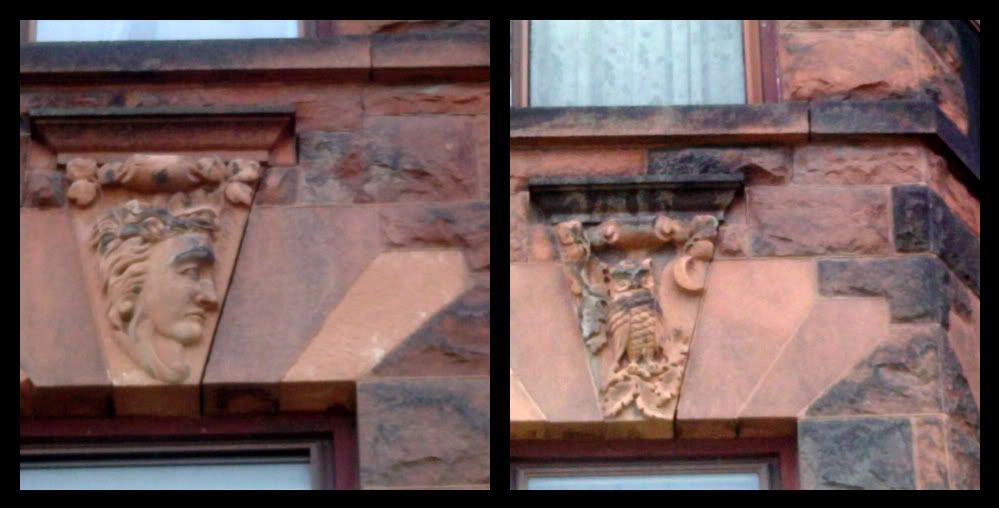 |
|
|
|
Post by fiona on Sept 13, 2010 18:42:59 GMT -5
Latcher's father in law, Milton Northrup.
|
|
|
|
Post by fiona on Sept 13, 2010 18:53:15 GMT -5
The head of a young man, quite handsome. Looks very much like Roscoe Conkling, only in the way that Conkling had a lock of hair in the front that curled down and the same kind of curly beard.  |
|
|
|
Post by fiona on Sept 13, 2010 19:12:41 GMT -5
Far north end of the building. Face of young woman with "frizzed bangs" a very popular style at the time. I think this is the image of Miss Mary Brandegee Wood, age 15, who died in the fire and her body was never found. I will say more about this in the next collage. Interestingally, the image is the only one that is blackened. About ten years ago, when I lived there, there was a fire on the first floor in the next apartment and they had to break out the front windows. The smoke and flames scorched the carving. Note also that the bricks to the right of "Mary" are also blackened, but those to the left are not.  |
|
|
|
Post by fiona on Sept 13, 2010 19:45:50 GMT -5
Despite the fuzzyness of the images, I think you can tell that these 3 constitute a family. The young girl has the man's eyes and the woman's mouth. The young girl could be Mary B. Wood, the man her father, John Brandegee Wood. And the woman, Mary's mother, Sarah Miller Wood, daughter of Rutger B. Miller. This fits the age profile for those three, the young girl appears to be a teenager, the man about 55 and the woman, middle aged, about 50, which Sarah was. The hairstyles are also a give a way. Sarah's style is typical of a middle aged matron and Mary's of a stylish young girl. John wears a Van Dyke beard. All 3 have the same type of collar at the neck and they also have the same foliate headdresses. The carvings of Sarah and John are next to each other, while Mary guards the far left hand corner of the buidling. Both Mary and Sarah were lost in the fire, while John escaped by climbing down the back fire escape from the 7th floor where they lived in the Genesee flats Apartment House.  |
|
|
|
Post by fiona on Sept 19, 2010 18:02:55 GMT -5
Below are the tops and bottoms of the columns we discussed in the Commentary pages as possibly being Masonic. I am sorry to break the flow of the thread, but I just put these on a disk. The carvings are very interesting and beautifully done as well.
|
|
|
|
Post by fiona on Sept 19, 2010 18:17:47 GMT -5
Here is an image from the bottom of the pillar showing a shield or crest surrounded bt acanthus leaves. Note the stars and that three are different.  |
|
|
|
Post by fiona on Sept 19, 2010 18:31:23 GMT -5
Here is the top of the column, Corinthian design, showing a floral motif with rosettes and berries or pomegranets ( top right) 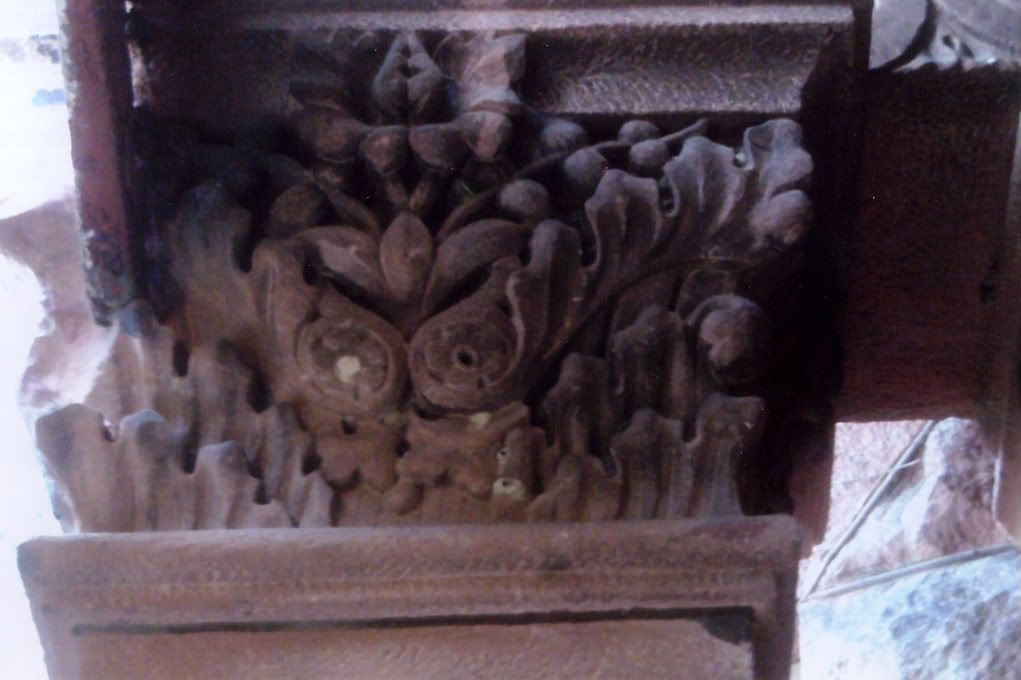 |
|
|
|
Post by fiona on Sept 19, 2010 18:46:20 GMT -5
for those unfamiliar with the pomegranate, check these images below. Compare the blossoms in the illustration at the far right with the rosettes on the column. 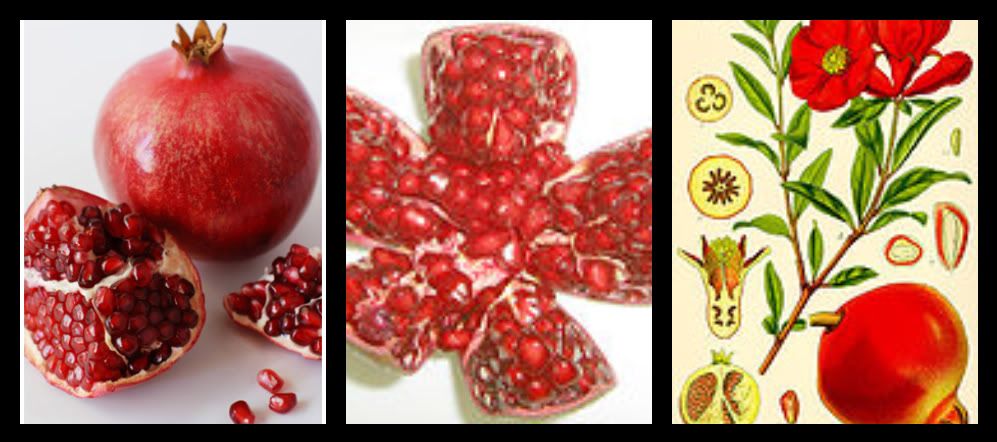 |
|
|
|
Post by fiona on Sept 27, 2010 15:06:08 GMT -5
Now we will go back to the carvings of the faces. This next image , on the far south side of the building, is possibly that of Mrs Susannah ( David) Hughes, a lady of about 60 years who fell from the fifth floor balcony onto Genesee Street and was subsequently so badly injured that she died that morning. I have made these assumptions about the carving because; 1. Mrs Hughes was an older woman. The carving clearly shows a woman beyond middle age. 2. The carving is placed almost directly below her apartment in the Genesee Flats and above the spot where she fell. For emphasis I have included this drawing from the Special Edition of the Saturday Globe.
|
|
|
|
Post by fiona on Sept 27, 2010 15:11:32 GMT -5
This image is remarkably well preserved and shows the patient reserve of this woman, as well as the lovely shape of her face and beautiful eyes. 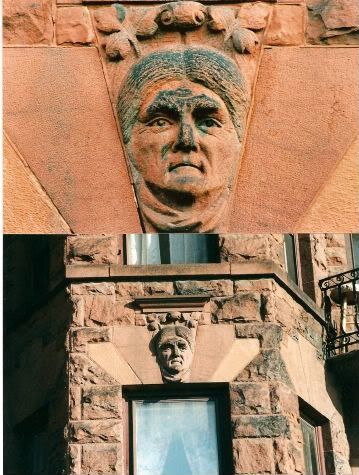 |
|
|
|
Post by fiona on Sept 27, 2010 15:17:26 GMT -5
So sad. 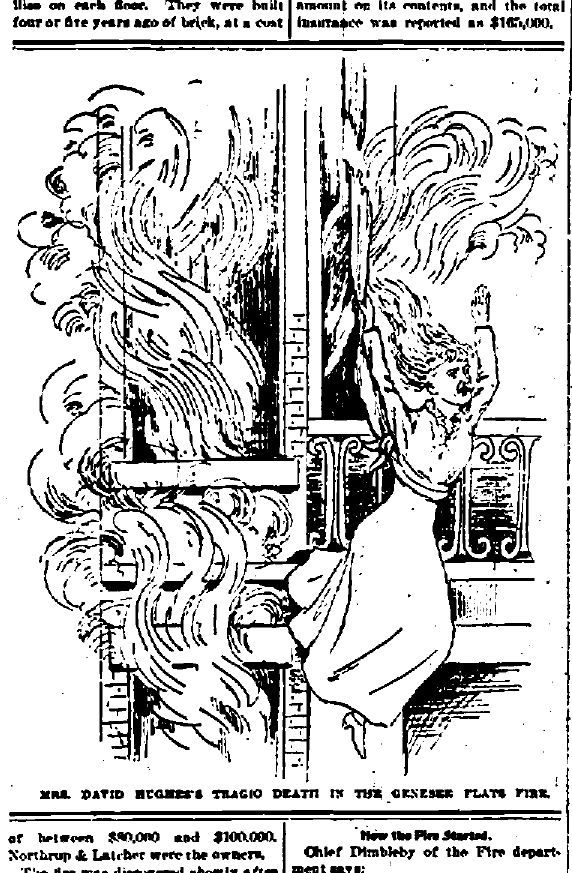 |
|